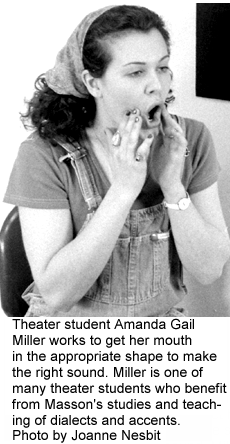The University Record, April 8, 1997
‘Watch your mouth’ is no reprimand
from this theater prof
By Joanne Nesbit
News and Information Services
 She’s listening, always listening. She tapes radio and video interviews, studies movies and is particularly attracted to documentaries. It is not the story line that interests Annette Masson, but who is speaking and how that person is speaking.
She’s listening, always listening. She tapes radio and video interviews, studies movies and is particularly attracted to documentaries. It is not the story line that interests Annette Masson, but who is speaking and how that person is speaking.
Masson, assistant professor of theater, coaches actors in Irish, French and Italian and such dialects as those of the American South and the Beatles’ Liverpool, to name a few. To learn any dialect and then to teach it, Masson says, she studies the way in which “native speakers” move their mouths and tongues and use their bodies to physically express words. She wants to know where the sound is coming from—the middle, the back or the front part of the mouth. She listens to the musicality of the dialect and the patterns of pitches that the accent creates. She researches the culture and climate from which each dialect emerges.
“French has a nasal sound,” Masson says. “If you want English with a French sound, then you have to give it that nasal twist. French women talk fairly high and don’t move their mouths too much.” Masson notes that the British speak from the front part of the mouth with precise articulation, but that Americans speak from the middle of the mouth with looser consonants. And Midwesterners flatten that sound a bit.
Topography and history can have an influence on speech and dialect, Masson says. “In the American South where it’s hot, the sounds are drawn out, they’re slow; the sound is pulled or drawled. Some of the syllables such as `ing’ are even taken away. It’s just too much work to move the tongue and the jaw. Some Southern sounds were affected by the African slave culture. But New Yorkers, surrounded by an aggressive and noisy city, speak in loud nasal tones influenced by the city’s mix of immigrants.”
Even within a small country there can be differences in dialects. In southern Ireland, Masson says, the speech is much more musical, moving to high and low tones. “This is the area of leprechauns, farms, lots of green and less depression. But in the northern part of Ireland, the speech sounds are harder, sharper and less musical. This is the area of more urbanization and factories and `tougher times.’ England’s Liverpool, the Beatles’ home town, is a heavy industrial area with bad air causing an adenoidal quality to the residents’ speech.”
One of the greatest resources for Masson and her students is authentic speakers. “U-M is a great field for study,” she says. “You can find people from all over the world here, and I tape them talking, getting them to tell stories about their childhood. Often when we talk about experiences in our youth, we revert back to a stronger native dialect. I listen to the rhythm and musicality of the speaker and try to figure out what I have to do to make that sound.”
Whatever dialect an actor uses, he still has to be understood by the audience, so a stage dialect may not be quite authentic. The most used stage dialects are British (the BBC style), Cockney, Irish, French, Spanish, and Scottish German. In the United States, the most popular are New York, Latino/a, African American and the Southern dialects of Texas and Georgia.
Masson also teaches accent reduction. “People from other countries now working in the American business world often want to reduce an accent in order to effectively communicate, especially in management positions,” Masson says. “They can learn to make vocal shifts and changes in their natural speech in order to find the music of the American sound.” Masson believes that dialects add a wonderful and delightful sound texture to any culture.

